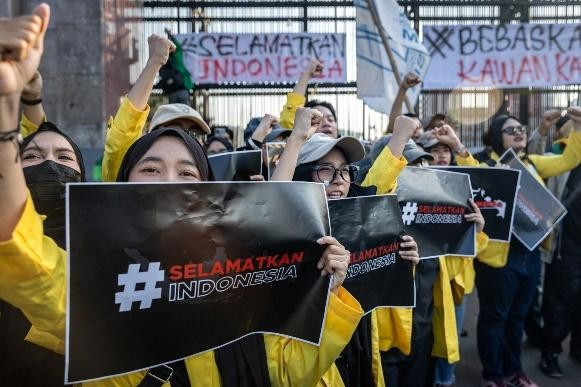Popular Reads
Top Results
Can't find what you're looking for?
View all search resultsPopular Reads
Top Results
Can't find what you're looking for?
View all search resultsWhy we should be concerned about the Red Sea crisis
As global supply chains undergo tightening, the looming risk of bottlenecks fueling inflation becomes pronounced, drawing parallels to the challenges encountered during the pandemic.
Change text size
Gift Premium Articles
to Anyone
 Up in arms: People lift rifles and placards as they chant during an anti-Israel and anti-United States rally in the Houthi-controlled capital Sanaa on Jan. 19, 2024, protesting the US designation of Yemen's Houthi rebels as “terrorists“, after a series of attacks on Red Sea shipping amid ongoing battles between Israel and the militant Hamas group in Gaza. (AFP/Mohammed Huwais)
Up in arms: People lift rifles and placards as they chant during an anti-Israel and anti-United States rally in the Houthi-controlled capital Sanaa on Jan. 19, 2024, protesting the US designation of Yemen's Houthi rebels as “terrorists“, after a series of attacks on Red Sea shipping amid ongoing battles between Israel and the militant Hamas group in Gaza. (AFP/Mohammed Huwais)
M
aritime transport, often described as the lifeblood of international trade, plays a paramount role in global logistics. According to the United Nations Conference on Trade and Development (UNCTAD), maritime transport is estimated to account for nearly 80 to 90 percent of global trade in 2022. It is a preferred mode of transport because of its cost-effectiveness compared to the faster yet more expensive alternative of using aircraft. For instance, maritime cargo with a transportation cost of US$300 would cost $1,200 when transported by aircraft. Consequently, maritime transport is widely recognized as the optimal choice, especially for voluminous cargo.
Given its significant impact on global trade, it is crucial to sustain affordable freight rates. A study conducted by Martincus in 2014 for Economic Letters underscores the magnitude of this issue, revealing that a mere 1 percent increase in freight rates can result in a substantial 6.5 percent decrease in firms' export values. This prompts reflection on the potential consequences of uncontrollable freight rates, suggesting that such a scenario could have far-reaching implications for the stability and viability of global trade.
With the escalation of geopolitical tensions, particularly the shift from Gaza to the Red Sea, where Houthi rebels are targeting vessels that transit the area, ostensibly as an expression of support for Palestine, there is a need for cautious anticipation regarding the positive outlook and stability of transportation and logistics in general.
The geopolitical landscape, marked by such disruptions, underscores the importance of vigilance and strategic planning to navigate potential challenges in the transportation and logistics sectors.
The ramifications of these disruptions are extensive. The decision to reroute vessels via the Cape of Good Hope to circumvent the Middle East, on average, extends journeys by 10 days. Analysts foresee a substantial increase of $1 million in costs per ship because of the incurred delays and higher bills. This redirection has already taken a toll on global trade, which witnessed a 1.3 percent decline in December that is predominantly attributed to reduced shipments through the Red Sea.
According to a report from the German economic institute IfW Kiel, there has been a 60 percent decrease in the number of containers traveling through the Red Sea region. The figures have plummeted from approximately half a million in November to a mere 200,000 last month. As global supply chains undergo tightening, the looming risk of bottlenecks fueling inflation becomes pronounced, drawing parallels to the challenges encountered during the pandemic.
The impact of these developments is unavoidable, as is evident in recent data from Bloomberg Intelligence, which vividly portrays the gravity of the challenges confronting global trade, particularly along the critical Red Sea routes. Container freight rates have surged dramatically, highlighted by the Asia (Mainland China) to Europe route index skyrocketing by approximately 80 percent compared to December 2023.


















